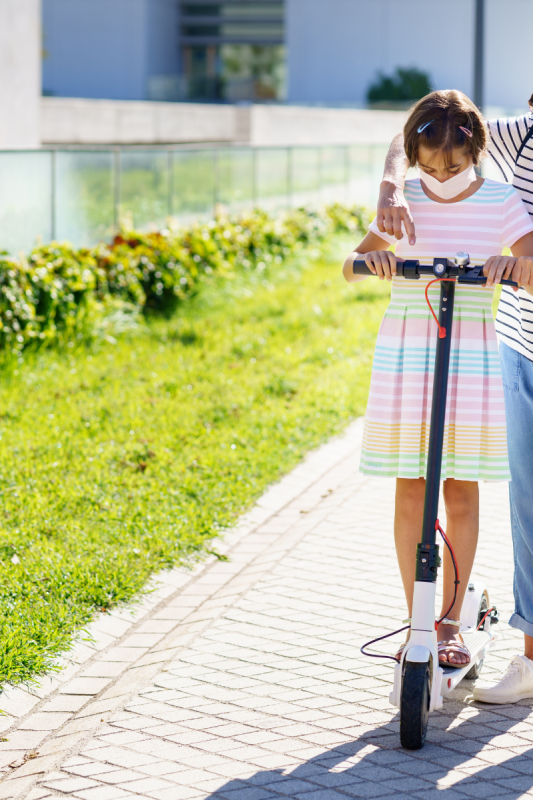Ride on Cars
Teaching Kids Responsible Riding Habits on Electric Scooters
Why Teaching Responsible Riding Habits is Important for Kids
Teaching responsible riding habits to kids is crucial before they start their journey on an electric scooter. By instilling these habits at a young age, we can help them develop a lifelong understanding of the importance of safety and etiquette on the road. Here are some key benefits of teaching responsible riding habits:
- Preventing accidents: Teaching kids about responsible riding can minimize the risk of accidents and injuries. Kids who understand the importance of following rules and practicing safe riding habits are less likely to engage in reckless behavior or take unnecessary risks.
- Promoting physical activity: Riding a bike is an excellent way for kids to stay active and healthy. By teaching them responsible riding habits, we can encourage them to engage in regular physical activity while ensuring their safety.
- Building confidence: Knowing how to ride a bike safely and responsibly can boost a child’s confidence. We empower them to navigate the road confidently and independently by teaching them the necessary skills and knowledge.
- Fostering respect for others: Responsible riding habits also promote respect for others on the road. We can instill empathy and consideration in their behavior by teaching kids about sharing the road with pedestrians, other cyclists, and motorists.
Overall, teaching responsible riding habits to kids is essential for their safety, physical well-being, confidence, and development of a respectful attitude toward others.
Understanding the Basics of Responsible Riding
Before we delve into teaching responsible riding to kids, we must understand the fundamental principles of reliable riding. These principles form the basis for safe and ethical behavior on the road. Here are some key aspects of responsible riding:
- Wearing helmets and protective gear: One of the most important aspects of responsible riding is wearing a helmet and other protective gear. Helmets can significantly reduce the risk of head injuries in a fall or accident. It’s essential to teach kids the importance of wearing helmets every time they ride.
- Following traffic rules and regulations: Responsible riders understand and follow traffic rules and regulations. This includes obeying traffic signals, stopping at stop signs, and yielding to pedestrians. By teaching kids the laws of the road, we equip them with the knowledge to navigate safely.
- Being visible and predictable: Responsible riders make themselves visible to others on the road. This includes wearing bright or reflective clothing, using lights when riding at night, and signaling their intentions. By being predictable, riders can help others anticipate their movements.
- Respecting others on the road: Responsible riders show respect and consideration for pedestrians, other cyclists, and motorists. This means giving pedestrians the right of way, sharing the road with others, and avoiding aggressive or reckless behavior.
Kids can ensure their safety and contribute to a harmonious and respectful road environment by understanding and practicing these basic principles of responsible riding.
Teaching Kids the Rules of the Road
By following these strategies, we can effectively teach kids the rules of the road and empower them to navigate safely and responsibly.
Developing Good Riding Habits
In addition to understanding the rules of the road, developing good riding habits is essential for safe and responsible cycling. Here are some key aspects to focus on when teaching kids:
- Proper bike maintenance and inspection: Teach kids the importance of regular bike maintenance, including checking tire pressure and brakes and ensuring all parts are in good working condition. Show them how to inspect their bikes before each ride to identify potential issues.
- Riding in a straight line: Emphasize the importance of riding in a straight line to maintain stability and avoid collisions. Teach kids to keep a consistent distance from the curb or edge of the road.
- Signaling intentions: Teach kids how to use hand signals to communicate their intentions to others on the road. This includes signaling turns, stops, and lane changes. Practice these signals in a safe environment until they become second nature.
- Staying alert and aware: Teach kids to know their surroundings and anticipate potential hazards. Emphasize the importance of scanning the road ahead, checking blind spots, and listening for approaching vehicles.
- Riding defensively: Encourage kids to adopt a defensive riding mindset, assuming that others on the road may not see them or may not follow the rules. Teach them to be prepared to react to unexpected situations and to prioritize their safety.
By focusing on these aspects, we can help kids develop good riding habits that contribute to their safety and responsible behavior on the road.
Encouraging Safe Riding Practices
Lastly, let’s discuss strategies for encouraging safe riding practices in kids:
- Obeying traffic signals and signs: Teach kids the importance of following traffic signals and signs, including traffic lights, stop signs, and yield signs. Explain the consequences of disregarding these signals and reinforce the need to always follow them.
- Being aware of surroundings: Encourage kids to be mindful while riding. Teach them to look out for pedestrians, other cyclists, and vehicles. Emphasize the need to avoid distractions such as using electronic devices while riding.
- Anticipating potential hazards: Teach kids to anticipate potential hazards on the road, such as parked cars opening doors, pedestrians stepping into the street, or vehicles making sudden turns. Help them develop the ability to assess risks and make informed decisions while riding.
- Practicing situational awareness: Teach kids to assess their surroundings and adjust their riding behavior constantly. This includes being mindful of road conditions, weather conditions, and the behavior of other road users.
- Setting a good example: As adults, we must set a good example by practicing safe riding habits. Kids learn by observing and imitating, so we must demonstrate responsible riding behavior.
By implementing these strategies, we can create a culture of safe riding practices among kids and promote a safer road environment for everyone.










